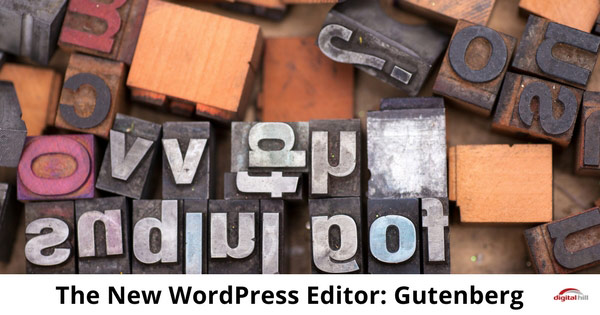The New WordPress Editor: Gutenberg

True innovation doesn’t exist in a vacuum, and for the website management system WordPress, that means the time has come for an update to its backend page content management editor. For the past six months behind the scenes, contributors and volunteers have been working on the first major update in a number of years. That effort will culminate with the release of Gutenberg, an update WordPress hopes will make adding rich content to your WordPress websites efficient and engaging.
Of course, it’s no coincidence that the new platform takes its name from the man who revolutionized the printed word in 1439 with a movable-type printing press. Gutenberg, the platform, will bring movable blocks to WordPress page editing, an innovation that will make website design more accessible and dynamic. It will replace TinyMCE as your default content editor for creating page content in the WordPress manager area.
A Good Case of Writer’s Block
While formatting the written word on websites with WordPress was always easy, anything beyond that required shortcodes, widgets, custom HTML, text formatting and embedding to achieve desired results. With the release of Gutenberg, all that goes away and is replaced by what WordPress is calling “blocks.”
WordPress is hoping website managers find the new block concept easy to understand and implement. It may seem like a simple concept, but once users have a feel for the new visual editor, WordPress is hoping it revolutionizes web development. They are hoping the new platform takes users beyond just writing articles. Instead, encouraging and aiding users into building more interesting and dynamic content layouts for their sites.
Pulling Back the Curtain
Right now, Gutenberg is available as a plug-in for WordPress 4.8 and higher. The full rollout will come with the release of WordPress 5.0 (no firm date set yet). The developers of Gutenberg are hoping the slow rollout of the new platform will allow them to make incremental changes to make it even more user-friendly before WordPress 5.0 goes live, sometime in 2018.
What to Know Before Jumping In
Even if Gutenberg represents a giant leap forward in web formatting, expect there to be something of a learning curve. Even if you are currently using Gutenberg as a plug-in, there will be some changes before the final release.
Many features that will be included with Gutenberg in WordPress 5.0 are either not included yet, or are not completely polished. It’s definitely a case of seeing the sausage get made at this point. With full transparency representing something of a double-edged sword for early adopters.
Gutenberg in its current iteration is also written using REACT javascript. The final version will be rewritten with a different library, so expect some changes there as well.
Either way, there’s no going back once you’ve updated to WordPress 5.0. Gutenberg will be the core default visual editor.
High Expectations
There’s no need to fear the changes Gutenberg will be bringing with it. However, as the pros far outweigh any cons associated.
Getting rid of TinyMCE will bring better integration between all the WordPress elements. Core, theme development, plugins, and the editor will all work more harmoniously. Instead of learning many different concepts to full utilize WordPress, Gutenberg will allow you to learn just one.
The development team believes Gutenberg will make it easier for beginners to pick-up and learn. It should also make for a less-distracting screen that gives you more usable screen space. Also, Gutenberg will work on mobile, allowing for quick edits even while you are on the go.
Overall, the new WordPress and Gutenberg in tandem should allow users to take that next jump forward in web design. You can take Gutenberg for a test drive now by downloading it from the WordPress repository.